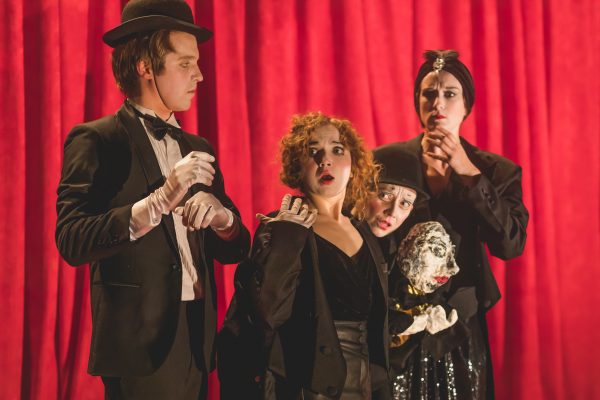Theater Commentary: A Memorable “Merchant of Venice” — Squeezing Blood Out of a Rubber Chicken
By Bill Marx
This was an enormously exciting production of Merchant of Venice, a reminder that theater can be (in fact, must be!) nervy.
The Merchant of Venice by William Shakespeare. Directed by Igor Golyak. Staged by the Actors’ Shakespeare Project at the Plaza Theatre, Boston Center for the Arts, Boston, MA. Closed: it had been scheduled through April 5.

Alejandro Simoes and Dennis Trainor in the Actors’ Shakespeare Project production of The Merchant of Venice. Photo: Igor Klimov.
This is not a review. It can’t be because I only saw this production in preview. But I raced out after I got a call from a respected source that this Merchant of Venice was something very special. So last Thursday night I went off to the Boston Center for the Arts’s Plaza Theatre. I figured that if I didn’t act fast there would be no show to see, given how quickly productions were cancelling out because of the COVID-19 virus. And I was right — that was its last performance, at least for now. My wife was not happy; I am a senior citizen and in a vulnerable demographic. But I am glad I made the trip because this was an enormously exciting production, a reminder that theater can be (in fact, must be!) nervy, a refreshing riposte to an increasingly homogenized stage scene in Boston. The effort, though clumsy at times, should be saluted so that, when it returns (I hope), it will be seen and argued about.
Director Igor Golyak’s concept is a head-shaker. Antonio (Dennis Trainor) comes on as stand-up comedian, in a glittery red jacket, delivering shtick at a center mic. (We are in a seedy Venetian nightclub, its decor awash in red. Kudos to scenic and costume designer Nastya Bugaeva.) He tells us audience participation will be demanded. And there is, highlighted by a bizarre sing-along to Dan Hill’s treacly 1977 hit “Sometimes When We Touch.” Antonio also insists that what we are about to see will be a comedy. A good time will be had by all. Applause signs flank the stage, lighting up at the emcee’s Pavlovian command.
So much for the character’s customary existential malaise; this Antonio delivers his opening lines to papier-mâché puppets he provides the voices for. Bassanio (Alejandro Simoes) comes on as a vapid romantic dunce, all plastic grins. Shylock (Nael Nacer) is inevitably accompanied by a sad sack music theme. He wears an ungainly white mask and delivers his lines with a thick stock-and-bull Yiddish accent. When Shylock removes his mask (whenever the Christians are out of sight) his speech and demeanor radically change: he seethes with a hard-edged anger. (Golyak ups the ante by tossing in sociopathic lines from Christopher Marlowe’s The Jew of Malta.) Antonio assures us we need not fear: the Jew will be soundly defeated for our delectation. After the “Hath not a Jew eyes” speech he congratulates Nacer for his superb delivery (there are meta-theatrical shenanigans throughout) and signals for the applause signs to flash.

Nael Nacer in the Actors’ Shakespeare Project production of The Merchant of Venice. Photo: Igor Klimov.
The proceedings are unsparingly cartoonish and frenzied, from Launcelot Gobbo (Jordan Palmer) singing his lines as he doodles on a portable piano slung around his neck to Jessica (Anna Bortnick) becoming fed up and then sexed-up after a forced dose of Shakespearean verse. As for the courtroom scene, a giant papier-mâché head (the Duke) presides, though Shylock quickly assumes command with homicidal energy: he puts plastic tarp down on the floor (taking too long a time to complete the task) to help clean up the mess once he has weighed Antonio and extracted his pound of flesh. I would note that, as the son of a kosher butcher, I figure Golyak might as well go the whole hog here (pun intended). There is a ritual for killing animals kosher, and that calls for hooking them by the heels and hoisting them up before slitting their throats. It seems to me that a steel hook or two on site would fit the rancid show-biz atmosphere of this production quite nicely.
There’s plenty of other surprises here that I don’t want to spoil. What is the directorial intent? Reactions will vary. No doubt some will judge that this pitch black comic approach tips into anti-Semitism. For me, Golyak has split this schizoid problem play into two and sicced the two genres on each other (and us). Antonio demands that the audience experience the show as a happy farce, a reassuring romance in which Shylock is a grotesque villain who cares for nothing but death and his ducats. In contrast, Shylock sees himself as an obsessed hero in a revenge tragedy, playing the fool for the sake of having his vengeance on his major tormentor. This is the first production of the play in which I felt that Shylock could be seen as a kind of suicide bomber (in one scene, sticks of dynamite go off for comic effect). Shylock knows he may be destroyed for what he is doing (manipulating the system that oppresses him in order to kill a Christian), but he doesn’t care — destruction is all. Golyak pretty well cuts out the fifth act, bringing out a cage (an image of self-punishment?) for his dueling protagonists. Both Shylock and Antonio are in anguish because they are performers who have fallen tragically short — both have failed to make the staging (the text?) his own, to make it fit his sense of morality — both are trapped in defeat and hatred.
This is not a review, so I won’t comment on the acting and the staging, which were (understandably) not quite settled when I attended, particularly the action during the final scenes. I will make a couple of general observations of a dramaturgical nature. First, Golyak is mistaken about how he handles the zany physical farce style he is going for: it should not be all high-speed. There must be periods in which the performers and production settle down, to let the audience think, or to give the performers a chance to supply quiet laughs by tossing lines away (Nacer modulates some of his speeches effectively). The courtship antics featuring Portia (Gigi Watson), Nerissa (Mara Sidmore), and suitors are tossed off, which lets the text’s racism slide by: “Let all of his complexion choose me so.”
Also, the strategy with the masks becomes pretty confusing — sometimes Shylock has his on and sometimes not and I was not sure why. And when Portia takes off her mask in the courtroom scene, wouldn’t someone notice that the lawyer is a woman? And why does she remove it, anyway? Also, I respect the director’s conceptual strategy: transforming Antonio, Jessica, and Shylock into satiric caricatures means speeches that express their humanity must be removed or toned down, thus Portia’s “the quality of mercy” soliloquy is downplayed. But there are lines I love in Merchant, and I miss them. When Tubal (sadistically) tells Shylock that Jessica swapped a ring — for a monkey — that had been given to Shylock by his wife, his response is the poignant “I would not have given it for a wilderness of monkeys.” Excised here because it suggests Shylock’s love for another.

Peter Walsh, Anna Bortnick, Mara Sidmore, and Gigi Watson in the Actors’ Shakespeare Project production of The Merchant of Venice. Photo: Igor Klimov.
But these are quibbles about a production-in-progress that, even in its early stages, amuses and, on occasion, amazes. This provocative Merchant is an invaluable reminder that during a dispiriting time of theatrical hiatus, we must help the troupes on the margins. The semicommercial fare served up by the city’s wealthy companies — the American Repertory Theater and the Huntington Theatre Company — is as safe as Fort Knox, even though the fat investment portfolios of their donors/majordomos might be slimmed down for a time. The medium and small-sized theaters, such as the Actors’ Shakespeare Project and Golyak’s Arlekin Players Theatre, teeter on the economic edge. Unless we support the vulnerable risk-takers, there is no guarantee the edgy will survive the downturn.
Bill Marx is the editor-in-chief of the Arts Fuse. For over three decades, he has written about arts and culture for print, broadcast, and online. He has regularly reviewed theater for National Public Radio Station WBUR and the Boston Globe. He created and edited WBUR Online Arts, a cultural webzine that in 2004 won an Online Journalism Award for Specialty Journalism. In 2007 he created the Arts Fuse, an online magazine dedicated to covering arts and culture in Boston and throughout New England.

Sounds exciting! Hope it returns. Stay safe.